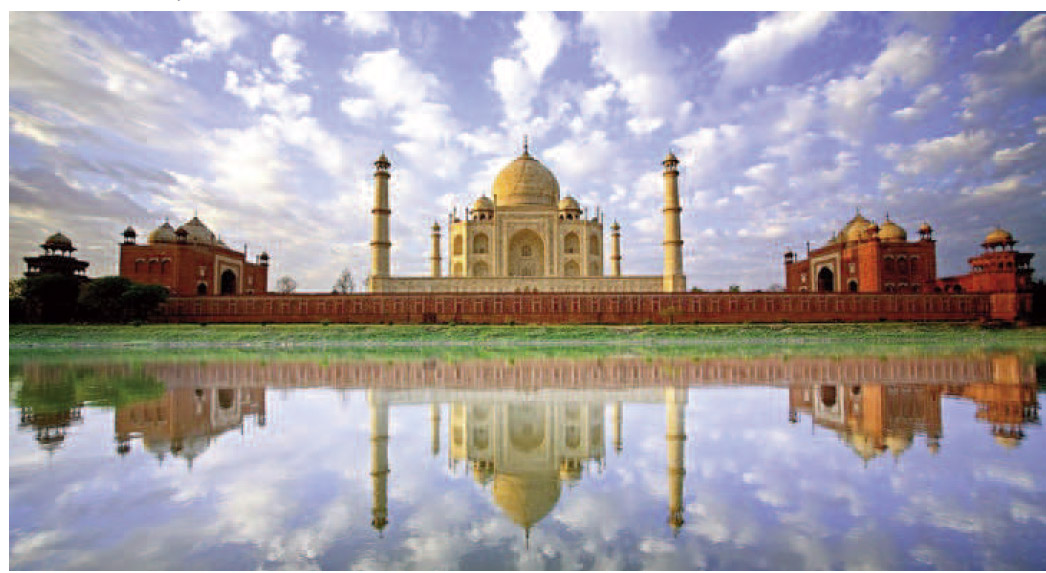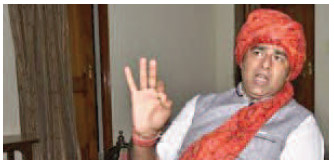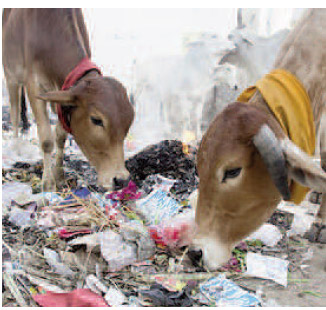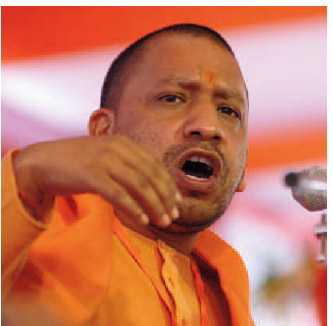Governing India
Not by the prism of communal politics
 Let the Taj not be the victim of whims and fancies of some perverted minds of the ruling clique!
The spirit of India and its rich multi-dimensional heritage must not be seen through the peep-hole of
communal politics.
Let the Taj not be the victim of whims and fancies of some perverted minds of the ruling clique!
The spirit of India and its rich multi-dimensional heritage must not be seen through the peep-hole of
communal politics.
 Hari Jaisingh
Hari Jaisingh
"History is not a pack
of tricks we play
upon the dead". The
observation by 18th
century French
historian and
philosopher Francois Marie
Arout, popular by his non de
plume Voltaire, was known
for his wit and attacks on the
established orthodoxy, then
symbolized by the Catholic Church. Voltaire stood for
liberal values, free society
and civil liberties.
 The Taj Mahal "is a blot on
Indian culture and history",
says BJP MLA Sangeet Som
I am recalling Voltaire's
thoughts during the age of
Enlightenment since they
happen to be relevant to
present-day India in the wake
of putting the Taj Mahal in the
cross hairs of controversial
statements by some BJP leaders. Uttar Pradesh's BJP
MLA Sangeet Som has
questioned the 17th century
architectural marvel's place in
India's heritage and said
history would be "rewritten to
erase Mughal emperors from
it". This is absurd, to say the
least
The Taj Mahal "is a blot on
Indian culture and history",
says BJP MLA Sangeet Som
I am recalling Voltaire's
thoughts during the age of
Enlightenment since they
happen to be relevant to
present-day India in the wake
of putting the Taj Mahal in the
cross hairs of controversial
statements by some BJP leaders. Uttar Pradesh's BJP
MLA Sangeet Som has
questioned the 17th century
architectural marvel's place in
India's heritage and said
history would be "rewritten to
erase Mughal emperors from
it". This is absurd, to say the
least
As it is, new socioeconomic
tensions are
surfacing at all levels of our
society following varied
crimes, communal and
caste violence and cow
vigilantism. Statistics of
social and economic
realities on the ground are
d i s q u i e t i n g ,
notwithstanding the big
promises for a better tomorrow held out by the
powers-that-be from time
to time, including today's
ruling establishment of the
BJP-led NDA regime of
Prime Minister Narendra
Modi. The grassroots
realities are telling. They
spell out the dangerous
dimensions of growing
intolerance in Indian
society.
 Cows eating rubbish
"If the country is most
peace-loving, how could
people take to the
streets and dulge in reckless
violence, even in the name of
cow protection? But, who
cares for cows? We see them
loitering on the streets
helping themselves with the
rubbish, including plastic bags. There must be
something terribly wrong with
the way we conduct our
governance, political culture
and social growth", a dhoti -
clad Gandhian told me the
other day regretfully.
K. J. Charles, a Canadian
Professor of Economics, once
expressed the view that had
the country taken the
Gandhian vision seriously,
intelligently applying and
adopting it, it would not only
have brought improvement in
the standards of living of the
masses but would have also
introduced a new and just
pattern of economic and social development.
Cows eating rubbish
"If the country is most
peace-loving, how could
people take to the
streets and dulge in reckless
violence, even in the name of
cow protection? But, who
cares for cows? We see them
loitering on the streets
helping themselves with the
rubbish, including plastic bags. There must be
something terribly wrong with
the way we conduct our
governance, political culture
and social growth", a dhoti -
clad Gandhian told me the
other day regretfully.
K. J. Charles, a Canadian
Professor of Economics, once
expressed the view that had
the country taken the
Gandhian vision seriously,
intelligently applying and
adopting it, it would not only
have brought improvement in
the standards of living of the
masses but would have also
introduced a new and just
pattern of economic and social development.
Why induct religious and
nationalism issues in the
march of Indian history?
History is a mirror that shows
our strength as well as
weaknesses of the period
under reference. And
historical monuments have to
be seen as a constant
reminder of lessons we could
learn from history. And
lessons can be learnt not by
rewriting history or by
demolishing or downgrading a
structure.
Many Indians think
likewise. But in the absence
of the requisite political will
to go in for hard options,
Indian leaders have always
looked for shortcuts to catch
up with the West. This has led
to shortfalls in targets and
policies.
Just look at Prime Minister
Modi's ill-conceived measure
of notebandi which took into
account neither harsh rural
realities nor the ordeals
ordinary citizens would have
to go through. Small wonder,
the economic growth has
been put in reverse gear,
rendering lakhs of workers
and youngsters jobless.
The panic button of 2019
has now sent shock waves in
the Modi establishment. But
the damage has already been
done. The people have lost
confidence in the fairness of
the system as we see big gaps
between promises and
performance by the ruling
class.
The polity in India's
Republic over the past 70
years has indeed plummeted
the depth of decadence falling from the heights of
Mahatma Gandhi and other
leading lights of the nation.
 "The Taj is a pride of India",
says UP CM Yogi Adityanath. He
virtually snubs Som & Co. by
his forthright remark
I believe in an objective and
honest appraisal of events so
that the facts are seen as
facts, howsoever bitter, both
by the leaders and the led.
The fate of the nation cannot
be changed by distorted facts
and false promises. Nor can
the diversionary tactics and
illusionary proposition by the
New Class of power-puffed
leaders change the course of
history. Such persons ought
to remember that only the
right inputs from the
grassroots as well as from
history can make a difference
to the quality of decisionmaking
processes in a
complex polity like ours.
And learning from history is
a two-way process: To review
the present in the light of the
past and learning about the
past in the light of the
present. Thus, the function of
history is to generate a
deeper understanding of both
past and present through the
process of inter-relation
between them.
"The Taj is a pride of India",
says UP CM Yogi Adityanath. He
virtually snubs Som & Co. by
his forthright remark
I believe in an objective and
honest appraisal of events so
that the facts are seen as
facts, howsoever bitter, both
by the leaders and the led.
The fate of the nation cannot
be changed by distorted facts
and false promises. Nor can
the diversionary tactics and
illusionary proposition by the
New Class of power-puffed
leaders change the course of
history. Such persons ought
to remember that only the
right inputs from the
grassroots as well as from
history can make a difference
to the quality of decisionmaking
processes in a
complex polity like ours.
And learning from history is
a two-way process: To review
the present in the light of the
past and learning about the
past in the light of the
present. Thus, the function of
history is to generate a
deeper understanding of both
past and present through the
process of inter-relation
between them.
Iam against making
history a slave of
officialdom or the ruling clique's ornamental outfit.
Such official games are selfdefeating
and counterproductive.
I am raising these
issues in the light of the latest
move by UP Chief Minister
Yogi Adityanath's BJP
government to drop the Taj
Mahal from the government
booklet on tourism projects.
Of course, the UP
establishment has every right
to promote Hindu centres of
pilgrimage for tourism. But I
feel uncomfortable by the
official move to downgrade
the 17 century monument of
love built during the Mughal
period. What is particularly
disquieting is the mindset
that looks at the historical
monument through the prism
of Hindutva.
 UP minister Laxmi Narayan
Chaudhary
Laxmi Narayan Chaudhary,
the minister –in-charge of
religious affairs and culture,
claimed that the UP step was
necessary as the present UP
government was "rashtrvadi " (nationalist) and run on
"dharm niti " (religious policy).
He also wants the Taj Mahal
to be "replaced with the Guru
Gorakhnath Peeth".
UP minister Laxmi Narayan
Chaudhary
Laxmi Narayan Chaudhary,
the minister –in-charge of
religious affairs and culture,
claimed that the UP step was
necessary as the present UP
government was "rashtrvadi " (nationalist) and run on
"dharm niti " (religious policy).
He also wants the Taj Mahal
to be "replaced with the Guru
Gorakhnath Peeth".
Why induct religious and
nationalism issues in the
march of Indian history? History is a mirror that shows
our strength as well as
weaknesses of the period
under reference. And
historical monuments have to
be seen as a constant
reminder of lessons we could
learn from history. And
lessons can be learnt not by
rewriting history or by
demolishing or downgrading
a structure.
Facts are sacred. They
cannot and should not be
tampered with. A flawed
perspective of history would
be disastrous. So would be
any emotional responses to
it. Emotions blur thinking and
create illusions.
We can go nowhere or
achieve nothing by
rewriting history or seeing
it selectively through
narrow religious or
sectarian angularities. The
questions that need to be
understood and addressed
are: how come a handful of
invaders could conquer this
country of sub-continental
dimensions without any
popular resistance?
Why is it that the periods of
effervescence in literature
followed in the wake of
conquerors and with their
degeneration, periods akin to
the Dark Ages set in? Why is it
that the disintegration of
every powerful dynasty
commenced simultaneously
with its attempts to
perpetuate its memory in
grandiose building projects?
Why is it that, while in other
countries the growth of
civilization from primitive
society to the present-day
industrial one has occurred in
a spiral fashion, in India it has
moved in cycles?
History is the source of
inspirations as well
as warnings. As a
vibrant democracy, we cannot
learn from the past by
destroying the structures of
history or renaming them.
The historical structures are
constant reminders of how
and where we went wrong as
people.
We cannot generate
nationalism or strengthen
Hindu identity by turning the
Taj Mahal into "Guru
Gorakhnath peeth" or
rewriting history to "erase"
Mughal emperors from it.. Let
the 17th century structure of
love remain as it is – as
tourists' love for an expensive
wonder in white marble!
The past is as much part of
our strength and weakness. It
is part of the glorious march
of the Indian civilization
which has survived in a state
of suspended animation, as it
were, for thousands of years.
Regrettably, in today's votebank
politics, leaders of all
shades and opinions, tend to
believe only in "quickies". We
have, however, to look
beyond and avoid politicizing
history by bisecting it into
different blocks of
communities, religions and
castes!
In any case, the Taj Mahal
is a symbol of eternal love.
It represents a King's love,
and craftsmen's toil and
sweat. Love knows no
boundaries or religious and
social barriers.It may be
the king's special
prerogative, but it is also
tourists' delight, both
"swadeshi " and "videshi ".
Let it not be the victim of
whims and fancies of some
perverted minds of the
ruling clique! The spirit of
India and its rich multidimensional
heritage must
not be seen through the
peep-hole of communal
politics.




 Let the Taj not be the victim of whims and fancies of some perverted minds of the ruling clique!
The spirit of India and its rich multi-dimensional heritage must not be seen through the peep-hole of
communal politics.
Let the Taj not be the victim of whims and fancies of some perverted minds of the ruling clique!
The spirit of India and its rich multi-dimensional heritage must not be seen through the peep-hole of
communal politics. Hari Jaisingh
Hari Jaisingh The Taj Mahal "is a blot on
Indian culture and history",
says BJP MLA Sangeet Som
The Taj Mahal "is a blot on
Indian culture and history",
says BJP MLA Sangeet Som Cows eating rubbish
Cows eating rubbish "The Taj is a pride of India",
says UP CM Yogi Adityanath. He
virtually snubs Som & Co. by
his forthright remark
"The Taj is a pride of India",
says UP CM Yogi Adityanath. He
virtually snubs Som & Co. by
his forthright remark UP minister Laxmi Narayan
Chaudhary
UP minister Laxmi Narayan
Chaudhary